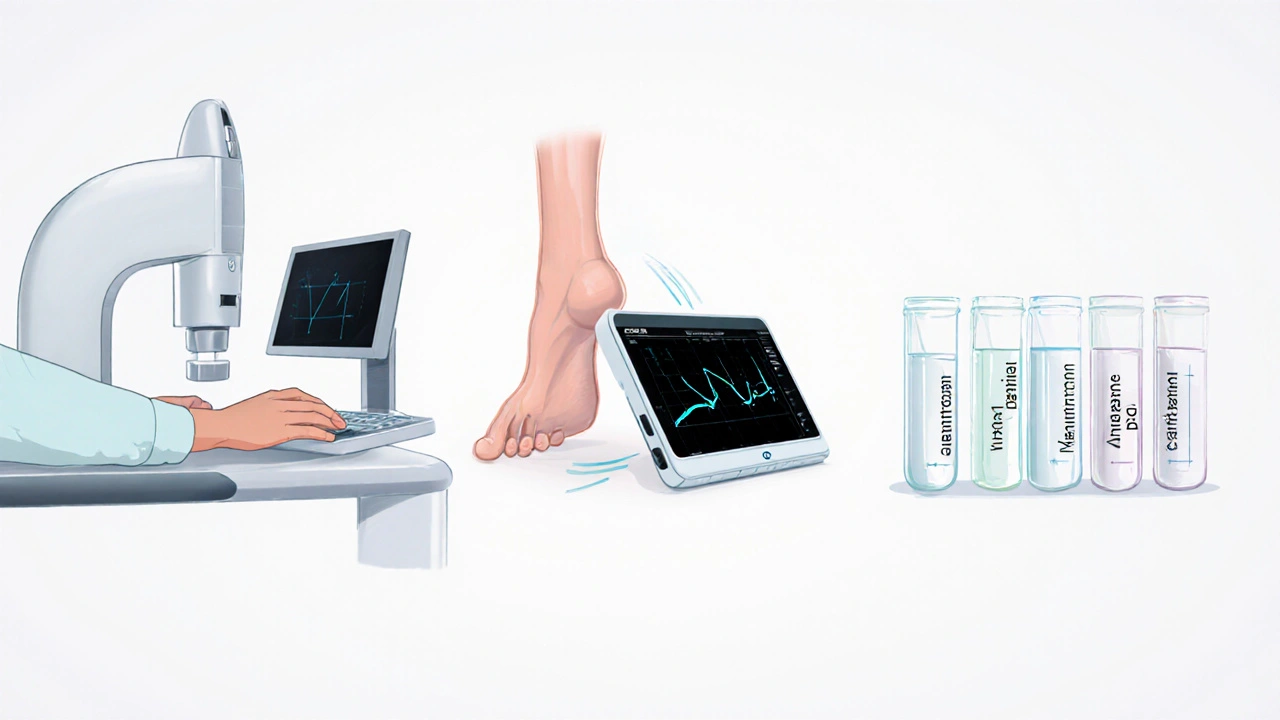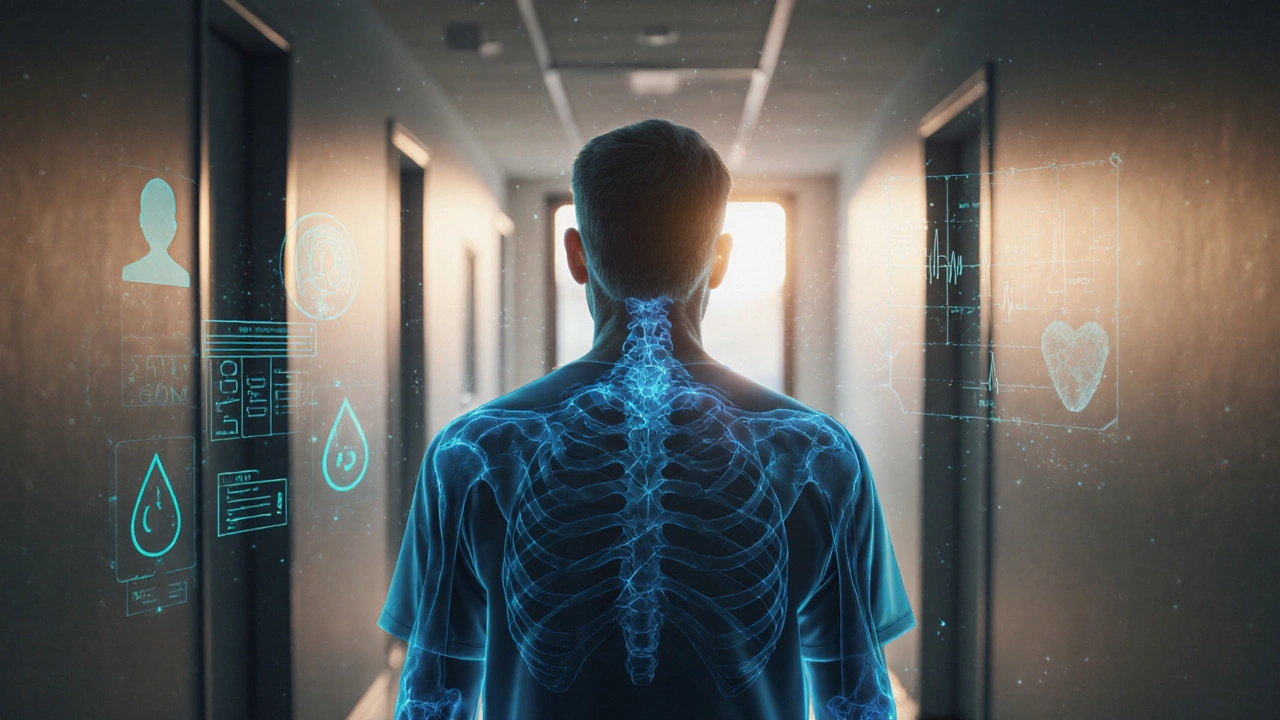Bone Health Risk Assessment Tool
Enter your details and click "Assess My Bone Health Risk" to see your personalized recommendations.
Key Takeaways
- Detecting bone problems early slashes the risk of fractures by up to 60%.
- DEXA scans are the gold‑standard for spotting low bone density before symptoms appear.
- Simple blood tests for calcium, vitamin D and bone turnover markers can flag trouble early.
- Regular lifestyle checks-diet, activity, smoking status-are cost‑free early‑warning tools.
- A personal screening schedule keeps bone health on track, especially after 50 or with risk factors.
Most people think bone damage only shows up when a painful fracture lands on their doorstep. In reality, the body sends subtle signals-quiet drops in density, hidden micro‑cracks, shifting hormone levels-long before a break occurs. early detection bone damage can turn a looming crisis into a manageable maintenance plan, preserving mobility and confidence well into the later years.
Bone Damage is a broad term that covers anything from gradual mineral loss to sudden fractures that compromise structural integrity. It can arise from osteoporosis, trauma, chronic inflammation, or metabolic disorders. When left unchecked, damaged bone becomes weaker, more brittle, and prone to repeat injuries.
Why Bone Health Matters Beyond the Bone
Strong bones support almost every movement you make. They protect vital organs, anchor muscles, and anchor calcium-a mineral essential for nerve signaling and blood clotting. When bone quality drops, the ripple effect touches balance, independence, and even mental health. Studies from the Australian Institute of Health show that a hip fracture in seniors leads to a 20% increase in one‑year mortality, underscoring the stakes of prevention.
Common Pathways to Bone Damage
- Osteoporosis is a chronic condition where bone resorption outpaces formation, thinning the trabecular network. It affects roughly 1 in 3 women over 65 and 1 in 5 men over 70.
- Chronic use of glucocorticoids, especially for asthma or rheumatoid arthritis, accelerates bone loss.
- Deficiencies in Calcium and Vitamin D reduce mineralization, leaving the skeleton porous.
- Sedentary lifestyles suppress bone remodeling signals, weakening the scaffold.
- Excessive alcohol, smoking, and high‑sodium diets add oxidative stress that erodes bone matrix.
How Early Detection Works
Early detection combines two ideas: spotting measurable changes before symptoms appear, and acting on those signals promptly. Think of it like a car’s dashboard-warning lights light up before the engine fails. In bone health, the “dashboard” includes imaging studies, blood markers, and risk‑assessment questionnaires.

Screening Tools You Can Trust
The most reliable methods fall into three categories: imaging, quantitative ultrasound, and biochemical markers. Below is a quick side‑by‑side look.
| Method | Primary Use | Accuracy (vs. DEXA) | Radiation Exposure | Typical Cost (AU$) |
|---|---|---|---|---|
| DEXA Scan (Dual‑energy X‑ray absorptiometry) | Measure bone mineral density (BMD) at hip & spine | 100% (gold standard) | Low (0.01mSv) | 120-180 |
| Quantitative Ultrasound (QUS) | Assess heel or radial bone quality | ≈80% (good for screening) | None | 40-70 |
| Standard X‑ray | Detect existing fractures or severe cortical thinning | Variable; not for BMD | Moderate (0.1-0.2mSv) | 30-60 |
| Blood Markers | Track calcium, vitamin D, and bone turnover (e.g., PINP, CTX) | Complementary, not standalone | None | 15-35 |
Creating a Personal Early‑Detection Plan
- Know Your Risk Profile: Use tools like FRAX (Fracture Risk Assessment Tool) to estimate 10‑year fracture probability based on age, sex, weight, previous fractures, and glucocorticoid use.
- Schedule Baseline Imaging: If you’re over 50 (or 40 with risk factors), book a DEXA scan. For younger adults with family history, a QUS can be a low‑cost first step.
- Track Biochemical Signals: Have a healthcare provider order serum calcium, 25‑OH vitamin D, and at least one bone formation marker every 1-2years.
- Review Lifestyle Quarterly: Log calcium intake (≈1,000mg/day for adults), vitamin D supplementation (800-2,000IU/day depending on blood levels), weight‑bearing exercise minutes, smoking status, and alcohol units.
- Set Re‑assessment Intervals: Repeat DEXA every 2-3years if BMD is normal, every 1-2years if you’re in the osteopenic range, or sooner after a fracture.
Lifestyle Hacks That Boost Early Detection
- Weight‑bearing Exercise: Activities like walking, dancing, and resistance training stimulate osteoblast activity. Aim for 150minutes a week.
- Calcium‑Rich Foods: Dairy, fortified plant milks, sardines, and leafy greens supply the mineral backbone.
- Vitamin D Sunshine: 10-30minutes of midday sun (depending on skin tone) in the Australian summer hits target levels without overexposure.
- Avoid Excess Salt & Caffeine: High sodium causes calcium loss; limit coffee to ≤2 cups daily.
- Quit Smoking & Limit Alcohol: Both impair osteoblast function and increase resorption.
Quick Checklist for Patients
- ✔ Have you had a DEXA scan in the past 2years (or earlier if risk factors apply)?
- ✔ Do you know your latest vitamin D level?
- ✔ Are you meeting the weekly 150‑minute weight‑bearing goal?
- ✔ Is your calcium intake at least 1,000mg per day?
- ✔ Have you filled out a FRAX or similar risk questionnaire this year?
What Happens After a Positive Screening?
If a scan shows low BMD (T‑score ≤‑2.5), your doctor may start anti‑resorptive medication such as bisphosphonates or newer agents like denosumab. However, medication is most effective when paired with lifestyle changes outlined above. Regular follow‑up appointments allow you to monitor treatment response via repeat DEXA and blood markers.

Frequently Asked Questions
How often should I get a DEXA scan?
For most adults over 50, a scan every two to three years is sufficient. If you have osteopenia, a fracture history, or are on long‑term steroids, talk to your doctor about yearly testing.
Can a blood test replace a bone density scan?
Blood markers give clues about bone turnover but cannot quantify density. Use them alongside imaging for a full picture.
Is Quantitative Ultrasound reliable for osteoporosis screening?
QUS is a good front‑line tool, especially in community settings, because it’s radiation‑free and cheap. However, a positive result should be confirmed with DEXA for treatment decisions.
What lifestyle changes have the biggest impact?
Weight‑bearing exercise, adequate calcium and vitamin D, quitting smoking, and limiting alcohol together can improve BMD by up to 2% per year, according to a 2023 meta‑analysis.
Can men benefit from early detection?
Absolutely. Men over 65 have a 20% chance of experiencing an osteoporosis‑related fracture, and early screening can halve that risk.
Taking control of bone health starts with seeing the silent changes before they break you. With the right tests, a solid risk‑assessment routine, and everyday habits that nurture the skeleton, you can keep your bones strong, flexible, and fracture‑free for decades.

16 Comments
Rashi Shetty October 3 2025
Early detection of bone deterioration is not merely a medical recommendation; it is a moral imperative for anyone who values long‑term health and independence. 🦴 By scheduling regular DEXA scans and routine blood work, you demonstrate responsibility not only to yourself but also to the family members who rely on your vitality. The data gathered today can prevent a fracture tomorrow, sparing both emotional distress and costly healthcare interventions. Ignoring these preventive measures borders on negligence, especially when evidence clearly shows a 60 % reduction in fracture risk with timely screening. Let us all act with the foresight and compassion that our aging bodies deserve. 😊
Queen Flipcharts October 4 2025
From the lofty perspective of national pride, a robust populace reflects a nation's strength. The United States has long championed cutting‑edge medical innovations, and embracing early bone health assessments aligns with that heritage. When citizens proactively seek DEXA scans, they not only safeguard personal well‑being but also uphold the collective vigor of our great country. Let us remember that the fortitude of a nation is measured by the health of its people, and bone health is a cornerstone of that foundation. In this spirit, I urge every fellow patriot to prioritize early detection without delay.
Yojana Geete October 5 2025
Oh my god you guys the bone thing is like a secret mission hidden in your body every day it whispers warnings but we ignore it it’s sad and dramatic how our bodies can scream silently
Jason Peart October 5 2025
Hey there, i totally get how overwhelming all those test results can be. Just remember that early detection is like a safety net, it catches you before any big oops happens. Start with a simple DEXA scan, then talk to your doc about vitamin D levels. Keep moving-short walks or dancing in your living room work wonders. And don't stress about perfection; even small changes add up to big wins for your bones. You've got this!
Jolanda Julyan October 6 2025
When we consider the cascade of events that leads from silent bone loss to a catastrophic fracture, the importance of early detection becomes unmistakably clear. First, the physiological process of remodeling slows down with age, allowing micro‑cracks to accumulate unnoticed. Second, lifestyle factors such as sedentary habits and poor nutrition exacerbate this hidden deterioration. Third, genetic predispositions can accelerate bone resorption without any outward symptoms. Fourth, many individuals remain unaware of their risk because routine check‑ups rarely include bone density assessments unless prompted. Fifth, the healthcare system often emphasizes treatment after injury rather than prevention before injury. Sixth, this reactive approach inflates medical costs and diminishes quality of life. Seventh, DEXA scans provide a quantifiable metric, the T‑score, that can stratify patients into low, moderate, or high risk categories. Eighth, early identification of a low T‑score enables clinicians to prescribe bisphosphonates or lifestyle interventions in a timely manner. Ninth, supplementation with calcium and vitamin D has been shown to improve bone mineral density when initiated early. Tenth, regular weight‑bearing exercise stimulates osteoblast activity, further fortifying skeletal structure. Eleventh, routine blood tests for calcium and vitamin D levels serve as a complementary surveillance tool. Twelfth, patient education about modifiable risk factors empowers individuals to take proactive steps. Thirteenth, insurance providers are beginning to recognize the cost‑effectiveness of preventive screening, offering coverage for baseline DEXA scans after age fifty. Fourteenth, community health programs that incorporate bone health questionnaires can flag at‑risk individuals for further evaluation. Fifteenth, integrating technology such as mobile apps to track calcium intake and activity levels enhances adherence to preventive regimens. Finally, the cumulative effect of these measures is a substantial reduction in fracture incidence, preserving mobility, independence, and overall well‑being for aging populations.
Kevin Huston October 6 2025
While your list reads like a textbook essay, let's be honest: most people won't read fifteen sentences before scrolling past. A concise call to action-get a DEXA scan, eat greens, move daily-does the job without the fluff. No need for a novel when a single sentence can drive change.
Amanda Hamlet October 7 2025
Honestly, the whole early detection craze is just a marketing gimmick pushed by pharma companies who want to sell more supplements. You don't need a fancy scan when you can just eat a glass of milk and call it a day. Trust me, I've read every study out there and most of them are funded by the same interests.
Nolan Jones October 7 2025
It's understandable to be skeptical about commercial influences, but the evidence for early bone density screening is robust and independent of industry funding. Numerous longitudinal studies have demonstrated that timely DEXA assessments lead to earlier intervention and lower fracture rates. Balancing healthy nutrition with objective medical testing provides the most comprehensive protection.
Mithun Paul October 8 2025
The presented data suffers from selection bias, as the sample predominantly includes Western subjects with access to advanced imaging. Consequently, the extrapolation to global populations, especially low‑resource settings, lacks validity. Moreover, the cost analysis omits indirect expenses such as lost productivity post‑fracture, rendering the economic argument incomplete.
Sandy Martin October 9 2025
I appreciate the depth of the article and the thorough breakdown of screening modalities. For readers seeking a quick starting point, I recommend scheduling a baseline DEXA scan at age 50, followed by a repeat every two to three years if results are normal. Pair this with annual vitamin D testing to ensure optimal bone health.
Steve Smilie October 9 2025
While the advice is serviceable, one must recognize that true osteological mastery transcends routine scans; it involves integrating advanced biomarkers and genomic profiling to anticipate skeletal compromise before conventional metrics detect it.
Josie McManus October 10 2025
Hey fam, just wanted to say that taking those small steps-like a quick walk after dinner or adding a handful of almonds to your snack-can make a huge difference over time. It’s easy to feel overwhelmed by all the medical jargon, but remember that consistency beats perfection. Keep at it, and your bones will thank you for the love you give them.
Heather Kennedy October 10 2025
In reviewing the post, I've noted a few syntactic inconsistencies: the phrase "bone damage" should be hyphenated when used as a compound adjective (e.g., "bone-damage prevention"). Additionally, the abbreviation "DEXA" ought to be defined upon first mention as "dual‑energy X‑ray absorptiometry (DEXA)." These minor adjustments will enhance clarity for a professional readership.
Michael Christian October 11 2025
Great catch on the terminology! Small edits like that really polish the piece and make the information more accessible. Thanks for pointing it out; your attention to detail helps everyone stay on the same page.
Steven Elliott October 11 2025
Sure, because reading a 600‑word dissertation on bone density is exactly how I spend my weekends.
paulette pyla October 12 2025
Congratulations on mastering the art of vacuum‑cleaning your intellectual curiosity; perhaps next you'll discover that the world rotates around your personal opinions.